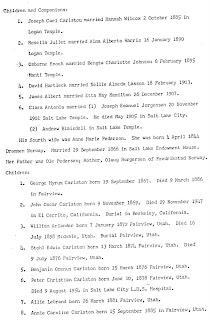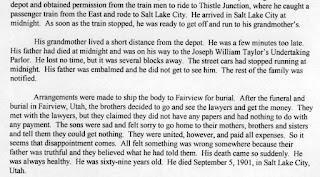Monday, March 7, 2011
Saturday, March 5, 2011
How do you pronounce Hans?
Perhaps we'll need a native Norweigian to settle the debate, but I've heard our family historians pronounce Hans' name two different ways. One sounds like 'hands' without the 'd' while the other sounds like the beginning of "Haunakah." What say ye on the correct way to pronounce Hans' name?
Early Norwegian Converts, Church News, June 27,1987
(Courtesy of Peggy Carlston)
Deeply Rooted Past - Missionaries Came to Norway 136 Years Ago (per 1987)
By John L. Hart Church News staff writer
Fredrikstad, Norway
In this city’s old town are found reminders of early LDS missionaries who organized here a branch that has become Norway’s oldest continuous Church unit.
Not much has changed in the old town: centuries of wear show on its cobbled streets, on a wooden stock in the square, on an army command post and even on the jail where LDS missionaries were incarcerated by civil authorities.
The early missionaries walked over the footbridge that still spans a waterway, and through a tunnel that yet penetrates a mounded fortification surrounding the town.
Though jailed and persecuted after they arrived, those missionaries established a branch from which hundreds were converted who eventually emigrated and became stalwarts of the Church in the Mountain West. The Oslo Norway Stake was organized in 1977, and Fredrikstad Ward was organized in 1982. About 90 members now attend and a new building will soon be constructed.
One of today’s members is Willy Henning Hansen, an old-timer and history buff, who can point to the landing dock on the fjord where Svend Larsen, one of the first missionaries, docked his boat. Hansen sometimes visits the street where Elders Larsen, Hans F. Petersen and Jeppe J. Folkmann walked in 1852, and he points to the fjord’s channel where the first converts of Fredrikstad were baptized.
At the time the Church was introduced here, Norway was a seething cauldron of economic and religious reformation, according to historian George W. Haslam in The Norwegian Experience with Mormonism, 1842-1920.
Norway’s first LDS connection was actually made across the ocean in America, at Fox River, Ill., where a group of Norwegian idealists had settled. Some of these were converted in 1842, and became missionaries.
Norwegian sea captain Svend Larsen was converted in Copenhagen, Denmark, where in 1850, Apostle Erastus Snow was presiding.
Aware that Norway offered legal protection to “dissenting religions,” Elder Snow approved a mission to Norway. It was an optimistic Larsen who sailed toward his homeland in 1851. He arrived in Risor, Norway, on Sept. 11, 1851, where he found some success but was arrested by the sheriff. He was released but the incident was the beginning of continual harassment by the law.
He arrived in Fredrikstad in mid-July 1852, deterred by legal problems, but not conquered. He dubbed his boat, “Zion’s Lion,” and flew from the mast a pennant upon which was painted a golden lion. His “Mormon” boat became well-known and helped keep the Church’s profile high.
Tradition has it that during the early years of the Church, missionaries were imprisoned in a Fredrikstad jail for several months. They sang hymns to passers-by and preached, continuing their missionary work.
The early missionaries were a sharp contrast to the local ministers. With rough-hewn manners, missionaries boldly confronted the well-educated ministers who were not trained in street debate. In a society seething for change, many Norwegians were converted. Old Norwegian state church records show columns and columns of members excommunicated because they had joined the Mormons.
Opposition was strong against the early members. A local newspaper boasted that the Mormons had been nearly eradicated and were likely to be slow in returning. The eradication was often done by peasants and framers organized into hunting and chasing groups that persecuted early converts. Some were killed, others emigrated. Altogether between 1852 and 1920, 3,292 LDS converts came to America.
Over the years, the emigration of leaders and other trials took a toll on the Fredrikstad Branch.
In the 1970s, the branch was very small with Oddvar Forsberg and his wife, Yvonne, attended as non-members.
Forseberg, bishop of what is now the Fredrikstad Ward, had earlier sent the missionaries away when they knocked on his door. Afterwards, he felt that he’d made a mistake, so he chased after them.
After being taught for months, the Forsbergs made their first visit to the small building where the branch met.
“We were hoping the Church was not true,” said Bishop Forsgren. “It was such an ugly building and such a small group.
One of the members playfully warned him, “Don’t get too close, or we’ll catch you in our nets.” Forsgren turned and walked out. This time missionaries chased after him. Later, Forsgren prayed about the Church and felt the answer come “Like switching on a 1,000-watt light bulb. I knew for sure the Church is true,” he said. “Since then I have never really doubted.”
The family was baptized in icy water and attended the ugly building with the small group, rejoicing in their testimonies.
“We had some tough times,” Bishop Forsgren recalled. “When we joined the Church, our friends left us. Other children couldn’t play with our children.”
Subscribe to:
Comments (Atom)





























































